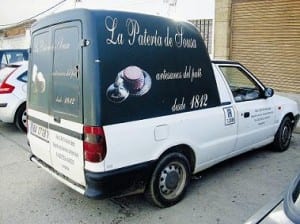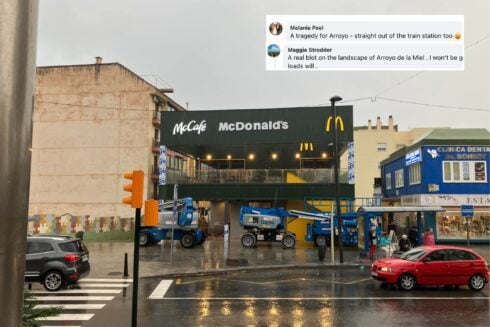I’VE been on some wild goose chases in my time, but they didn’t ever involve wild geese.
This was certainly a mission with a difference. ‘Go and find out how the world’s best foie gras is made was the order’.
And that is why, four hours after setting off from Andalucia, I was literally chasing a gaggle of geese around an olive grove in the backwaters of Badajoz.
For it turns out, as reported in the Olive Press last issue, that this obscure farm in the heart of Extremadura, is top of the global foie producers.
A beak and wings above its main rivals in France, the smallholding has not only got America’s top chef Dan
Barber drooling over it, but even President Obama and Gordon Ramsay are counted as clients.
Obama himself ordered it to be served on the White House menu earlier this summer, after eating it at Barber’s New York restaurant with his wife Michelle.
Barber had beaten a trail to the obscure farm on a top secret mission last year, revealing nothing about himself or his restaurant, which was voted America’s Best this year.
A beak and wings above its main rivals in France, the smallholding has not only got America’s top chef Dan
Barber drooling over it, but even President Obama and Gordon Ramsay are counted as clients.
“The next thing we know we had orders on official notepaper from the White House,” explained Eduardo de Sousa, 42, who met me at his shop Pateria de Sousa, in Fuente de Cantos. “Things have really taken off since then.”
But, it is not so much the quality of the foie that is so interesting to note. It is the fact that Eduardo and his brother Pedro have managed to create a world-beating product that is officially “cruelty free”. And in Spain, of all places, to boot.
For those who need reminding, foie has become a much-maligned product in the restaurant trade alongside veal, red tuna and eating songbirds, as they occasionally do in Spain.
Created normally by force-feeding the geese to make their livers swell, the birds are fed up to a kilogram a day and often die through overfeeding.
Not so, at Pateria de Sousa. Over the last few years, the two hard-working, humble brothers have scooped numerous international awards and world-wide recognition by doing the exact opposite.
The Olive Press sent me out to find out their well-kept secret.
It didn’t initially bode well. Within minutes of arriving at the brothers’ shop, my early eagerness and excitement had all but dried up.
The bare truth was that the shop was, well, bare. My heart quickly sank, there was nothing to see and, most importantly, no world famous foie gras to sample.
Surely if this really was home to one of the world’s best gourmet products the shelves would be laden with the stuff.
Had I come to the wrong place? Was this an elaborate plot by the editor to get me out of the office for a brief day’s respite?
Thankfully not. On sensing my initial confusion, Eduardo promptly came to my aid to put my furrowed brow at ease.
He immediately began to explain: “The reason our foie is so special is because we only produce it on a yearly basis.
“At the moment, we are still rearing the current group of geese so that is why things are looking bare.
“Come February, March time, this place is going to be packed to the rafters with foie gras ready to be sold.”
My relieved smile also served to mask my undeniable sense of disappointment. Hungry as ever, I had hoped to be taste testing one of the world’s most coveted delicacies.
Unfortunately it wasn’t to be.
Eduardo regardless, had broken into his stride and was now enthusiastically revealing the ‘secret’ behind the acclaimed flavour of the foie gras.
My relieved smile also served to mask my undeniable sense of disappointment. Hungry as ever, I had hoped to be taste testing one of the world’s most coveted delicacies.
The secret is there isn’t really a secret. It is all about allowing nature and geese do what they do best – live in harmony together. No factories, no force feeding and no two-week rearing schedules.
“We let the geese grow naturally in the wild, we don’t force feed them, we let nature work its magic.”
Rather like the world-beating ham from the Iberian pigs that live in the same area, the geese get to live off acorns, olives and other natural produce.
“This provides them with natural fat and juices, as well as numerous nutrients, which creates the beautiful flavour.”
The Pateria de Sousa’s cruelty-free philosophy has been going strong since the farm first opened in 1812.
But, as Eduardo admits, until recent recognition life at the Pateria was anything but easy. In actual fact, the future was looking exceptionally bleak a mere three years ago.
“It is so tough to compete with the French and Americans. They have a two-week rearing schedule, we take a full year to nurture our geese.
“Due to overfeeding their goose livers can weigh up to two kilos, ours normally weigh just 500 grams in comparison.
“Despite the competition we stuck to our century-old principles and fortunately it has now paid off.”

Not one to be force fed a line, I wanted to check whether there was a catch. Where are the geese then, I asked?
And then began the wild goose chase proper, as we hurtled along on a tiny road half an hour from the village towards the district of Tentudia and the village called Pallares.
It was a race against time as we negotiated dirt tracks and muddy slopes in a determined bid to reach the geese before nightfall.
But it was well worth the wait. On stepping out of the car, I was greeted by two gaggles of geese, waddling along, heading for the nearby river.
Apparently healthy, moving freely and, crucially, without a metal enclosure in sight. These were surely the happiest birds I had ever seen.
This so-called goose chase was actually quite the opposite. I had now heard and seen at length why this little-known Extremaduran product is now coveted by the world’s leading restaurants.
Eduardo gave me the guided tour of the area. Sure enough, it was a veritable haven for acorns and olives. I asked Eduardo where they slept, his response was embarrassingly obvious.
“Outside, of course,” he hooted.
As dusk quickly enveloped us, it dawned on me the irony of my assignment.
This so-called goose chase was actually quite the opposite. I had now heard and seen at length why this little-known Extremaduran product is now coveted by the world’s leading restaurants.
And although the proof of the pudding is always in the eating, who am I to argue with Messrs Obama and Barber?!










However lofty the goals of Sousa and his American counterpart Dan Barber, reports from those who have actually tasted the elusive Spanish product say that it’s faux gras, not foie gras: perfectly acceptable goose liver, but not its fatty counterpart. While it’s lovely that the Obamas are willing to give it a try, it’s truly a stretch to say that Sousa’s liver is ‘coveted by the world’s leading restaurants.’ Note that on the 4 US foie gras farms, all of which raise ducks, none of them are kept in battery cages either. At Sonoma Foie Gras in California [which will be banned in 2012 unless current laws are changed], the ducks live ‘free range’ in a walnut orchard for most of their lives.
Semantics aside, Kate Janeway, the foie d’oie from Pateria de Sousa still won the Coup de Cœur. That’s a blind tasting, my dear, and gavage ou sans gavage, the end product is what’s important.